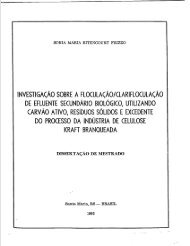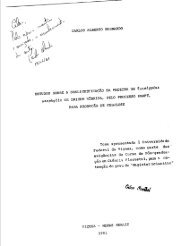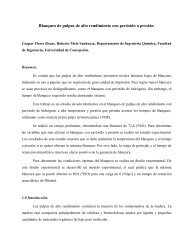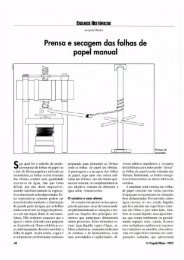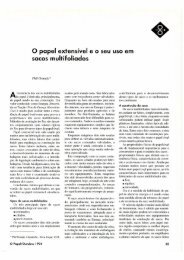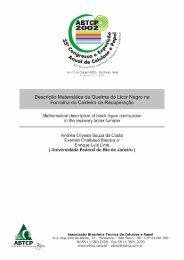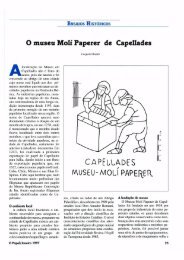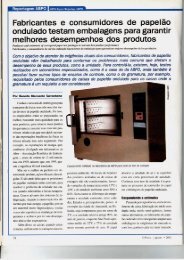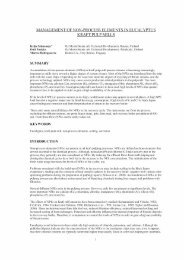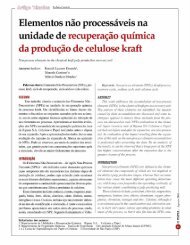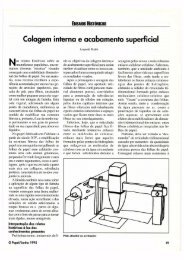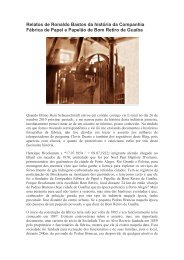O Eucalipto: um século no Brasil (The Eucalypt - Celso Foelkel
O Eucalipto: um século no Brasil (The Eucalypt - Celso Foelkel
O Eucalipto: um século no Brasil (The Eucalypt - Celso Foelkel
You also want an ePaper? Increase the reach of your titles
YUMPU automatically turns print PDFs into web optimized ePapers that Google loves.
1 9 6 B I L H Õ E S T O N E L A D A S D E C A R B O N O N O S E U C A L I P T A I S - 1 9 6 B I L L I O N T O N S O F C A R B O N I N T H E E U C A L Y P T S P L A N T A T I O N S<br />
123<br />
homem passou a desenterrar o carvão e a trazer o petróleo para a superfície. Cada vez que<br />
a China queima <strong>um</strong> pedaço de carvão mineral para produzir energia, ou alguém liga <strong>um</strong><br />
motor a gasolina, <strong>um</strong> pouco do carbo<strong>no</strong> capturado há centenas de milhões de a<strong>no</strong>s, volta<br />
à atmosfera.<br />
Na atmosfera, o dióxido ou gás carbônico, (CO2) absorve parte do calor emitido pelo Sol,<br />
impedindo que seja refletido de volta para o espaço. É o desequilíbrio entre a energia<br />
solar absorvida pela Terra e a devolvida ao espaço que gera o efeito estufa. Não é só o gás<br />
carbônico o responsável pelo processo, para o qual contribuem ainda o meta<strong>no</strong>, o óxido<br />
de nitrogênio e os clorofluorcarbonetos, porém, sobre o gás carbônico podemos atuar<br />
plantando árvores.<br />
É esse plantio e a redução das emissões por parte dos países industrializados que vão<br />
controlar as alterações climáticas, o derretimento das geleiras, a diminuição das calotas<br />
polares, o a<strong>um</strong>ento do nível do mar e conseqüentemente a redução da produção agrícola,<br />
o a<strong>um</strong>ento da desertificação, da fome e, em última instância, a extinção de animais e plantas,<br />
com a diminuição da biodiversidade.<br />
Since the plants sequestered carbon and released oxygen, the world became habitable<br />
to superior forms of life, eventually leading to the appearance of man. <strong>The</strong> problem is<br />
that but a few hundred thousand years after the first primates appeared, man started<br />
digging coal and lifting oil to the surface. Each time China burns a piece of mineral<br />
coal to produce energy, or someone switches a gas engine on, a little of the carbon<br />
captured hundreds of millions of years ago goes back into the atmosphere.<br />
In the atmosphere, carbon dioxide (CO2) absorbs part of the Sun’s heat, keeping it from<br />
being reflected back into space. It is the unbalance between the solar energy absorbed<br />
by the Earth and returned to space that causes the greenhouse effect. Carbon dioxide<br />
isn’t the only agent involved in the process. Methane, nitrogen oxide and chlorofluorocarbons<br />
also contribute, however, we can act against carbon dioxide by planting trees.<br />
Weather change, glacier melting, polar cap, sea level increases and, thus, reduced<br />
agriculture production, increased desertification, hunger and, lastly, animal and plant<br />
extinction due to reduced biodiversity can be controlled by planting and by the industrialized<br />
nations reducing their emissions.




